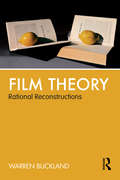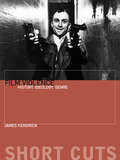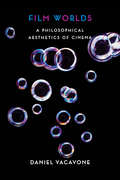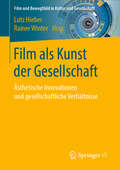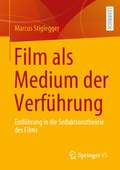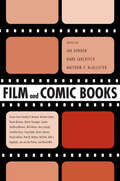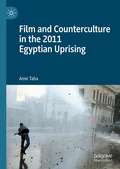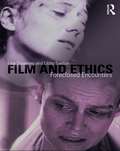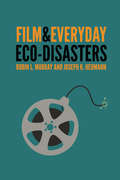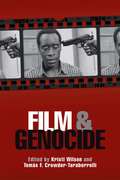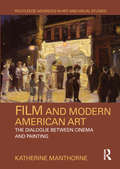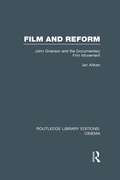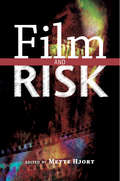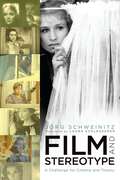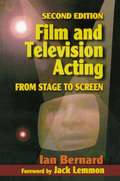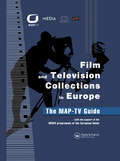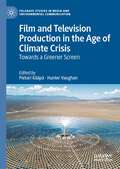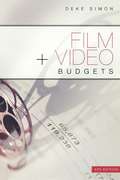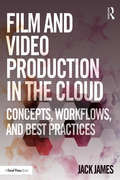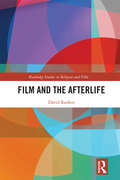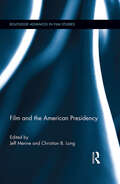- Table View
- List View
Film Theory: Rational Reconstructions
by Warren BucklandIn Film Theory: Rational Reconstructions, Warren Buckland asks a series of questions about how film theory gets written in the first place: How does it select its objects of study and its methods of inquiry? How does it make discoveries and explain filmic phenomena? And, How does it formulate and solve theoretical problems? He asks these questions of film theory through a rational reconstruction and a classical commentary. Both frameworks clarify and reformulate vague and inexact expressions, redefine obscure concepts, and examine the underlying logic of film theory arguments. This not only subjects film theory to rigorous examination; it also teaches students how to write theory, by enabling them to question and critically interrogate the logic of previous film theory arguments. The book consists of nine chapters that closely examine a series of canonical film books and essays in great detail, by Peter Wollen, Laura Mulvey, Thomas Elsaesser, Stephen Heath, and Slavoj Žižek, among others.
Film Violence: History, Ideology, Genre (Shortcuts Ser.)
by Jim KendrickA concise and accessible introduction to the role of violence from the silent era to the present, this volume illustrates the breadth and depth of screen bloodshed in historical, cultural, and industrial contexts. After considering problems of definition, the book offers a systematic history of film violence and examines three of the most popular violent genres: western, horror, and action. It concludes with a case study on the centrality of film violence to the directors of the New American Cinema, such as Francis Ford Coppola, Martin Scorsese, and Steven Spielberg, offering a strong example of how violence, history, ideology, and genre are deeply intertwined.
Film Worlds
by Daniel YacavoneDaniel Yacavone is Lecturer in Film Studies at the University of Edinburgh, where he has been acting director of Film Studies within the School of Literatures, Languages, and Cultures and has held a British Academy Postdoctoral Fellowship.
Film Worlds: A Philosophical Aesthetics of Cinema
by Daniel YacavoneDaniel Yacavone is Lecturer in Film Studies at the University of Edinburgh, where he has been acting director of Film Studies within the School of Literatures, Languages, and Cultures and has held a British Academy Postdoctoral Fellowship.
Film Worlds: A Philosophical Aesthetics of Cinema
by Daniel YacavoneFilm Worlds unpacks the significance of the "worlds" that narrative films create, offering an innovative perspective on cinema as art. Drawing on aesthetics and the philosophy of art in both the continental and analytic traditions, as well as classical and contemporary film theory, it weaves together multiple strands of thought and analysis to provide new understandings of filmic representation, fictionality, expression, self-reflexivity, style, and the full range of cinema's affective and symbolic dimensions.Always more than "fictional worlds" and "storyworlds" on account of cinema's perceptual, cognitive, and affective nature, film worlds are theorized as immersive and transformative artistic realities. As such, they are capable of fostering novel ways of seeing, feeling, and understanding experience. Engaging with the writings of Jean Mitry, Pier Paolo Pasolini, Christian Metz, David Bordwell, Gilles Deleuze, and Hans-Georg Gadamer, among other thinkers, Film Worlds extends Nelson Goodman's analytic account of symbolic and artistic "worldmaking" to cinema, expands on French philosopher Mikel Dufrenne's phenomenology of aesthetic experience in relation to films and their worlds, and addresses the hermeneutic dimensions of cinematic art. It emphasizes what both celluloid and digital filmmaking and viewing share with the creation and experience of all art, while at the same time recognizing what is unique to the moving image in aesthetic terms. The resulting framework reconciles central aspects of realist and formalist/neo-formalist positions in film theory while also moving beyond them and seeks to open new avenues of exploration in film studies and the philosophy of film.
Film als Kunst der Gesellschaft: Ästhetische Innovationen und gesellschaftliche Verhältnisse (Film und Bewegtbild in Kultur und Gesellschaft)
by Lutz Hieber Rainer WinterDer Band beschäftigt sich mit dem Kunstbegriff im Hinblick auf Film, wobei es sowohl um ästhetische Theorie als auch um konkrete Werke geht. Das Spektrum umfasst Spielfilme und Dokumentarfilme. Dabei liegt der Schwerpunkt auf den ästhetischen Innovationen des Mediums im Laufe seiner Geschichte und in der Gegenwart. Die Entwicklung visueller Ideen wird auf den historischen und gesellschaftlichen Kontext ihrer Entstehung und Rezeption bezogen. In den Blick geraten Filmautoren, Filmkünstler und Filmbewegungen, die nicht nur im Independent-Film, sondern auch im Mainstream zu finden sind.
Film als Medium der Verführung: Einführung in die Seduktionstheorie des Films
by Marcus StigleggerDie Seduktionstheorie definiert den Film im weiteren Sinne als ein Medium der Verführung, basierend auf dem französischen Begriff der séduction. Es handelt sich um einen von kontinentaler Philosophie und klassischer Filmtheorie geprägten theoretischen Ansatz, mit dem ein dreistufiges Analysemodell verknüpft ist. Das Buch führt in die theoretischen Grundlagen ein und stellt anhand unterschiedlicher klassischer und aktueller Beispiele aus der Filmgeschichte mögliche Analyseansätze vor.
Film and Comic Books
by Ian Gordon, Mark Jancovich and Matthew P. McAllisterContributions by Timothy P. Barnard, Michael Cohen, Rayna Denison, Martin Flanagan, Sophie Geoffroy-Menoux, Mel Gibson, Kerry Gough, Jonathan Gray, Craig Hight, Derek Johnson, Pascal Lefevre, Paul M. Malone, Neil Rae, Aldo J. Regalado, Jan van der Putten, and David Wilt In Film and Comic Books contributors analyze the problems of adapting one medium to another; the translation of comics aesthetics into film; audience expectations, reception, and reaction to comic book-based films; and the adaptation of films into comics. A wide range of comic/film adaptations are explored, including superheroes (Spider-Man), comic strips (Dick Tracy), realist and autobiographical comics (American Splendor; Ghost World), and photo-montage comics (Mexico's El Santo). Essayists discuss films beginning with the 1978 Superman. That success led filmmakers to adapt a multitude of comic books for the screen including Marvel's Uncanny X-Men, the Amazing Spider-Man, Blade, and the Incredible Hulk as well as alternative graphic novels such as From Hell, V for Vendetta, and Road to Perdition. Essayists also discuss recent works from Mexico, France, Germany, and Malaysia.
Film and Counterculture in the 2011 Egyptian Uprising
by Amir TahaThis book examines how film articulates countercultural flows in the context of the Egyptian Revolution. The book interrogates the gap between radical politics and radical aesthetics by analyzing counterculture as a form, drawing upon Egyptian films produced between 2010 and 2016. The work offers a definition of counterculture which liberates the term from its Western frame and establishes a theoretical concept of counterculture which is more globally redolent. The book opens a door for further research of the Arab Uprising, arguing for a new and topical model of rebellion and struggle, and sheds light on the interaction between cinema and the street as well as between cultural narratives and politics in the context of the 2011 Egyptian uprising. What is counterculture in the twenty-first century? What role does cinema play in this new notion of counterculture?
Film and Ethics: Foreclosed Encounters
by Lisa Downing Libby SaxtonFilm & Ethics considers a range of films and texts of film criticism alongside disparate philosophical discourses of ethics by Levinas, Derrida, Foucault, Lacanian psychoanalysts and postmodern theorists.
Film and Everyday Eco-disasters
by Robin L. Murray Joseph K. HeumannEco-disasters such as coal-mining accidents, oil spills, and food-borne diseases appear regularly in the news, making them seem nearly commonplace. These ecological crises highlight the continual tensions between human needs and the environmental impact these needs produce. Contemporary documentaries and feature films explore environmental-human conflicts by depicting the consequences of our overconsumption and dependence on nonrenewable energy.Film and Everyday Eco-disasters examines changing perspectives toward everyday eco-disasters as reflected in the work of filmmakers from the silent era forward, with an emphasis on recent films such as Dead Ahead, an HBO dramatization of the Exxon Valdez disaster; Total Recall, a science fiction action film highlighting oxygen as a commodity; The Devil Wears Prada, a comment on the fashion industry; and Food, Inc., a documentary interrogation of the food industry. The authors evaluate not only the success of these films as rhetorical arguments but also their rhetorical strategies. This interdisciplinary approach to film studies fuses cultural, economic, and literary critiques in articulating an approach to ecology that points to sustainable development as an alternative to resource exploitations and their associated everyday eco-disasters.
Film and Genocide
by Kristi M. WilsonFilm and Genocidebrings together scholars of film and of genocide to discuss film representations, both fictional and documentary, of the Holocaust, the Armenian genocide, and genocides in Chile, Australia, Rwanda, and the United States. Since 1955, when Alain Resnais created his experimental documentaryNight and Fogabout the Nazis' mass killings of Jews and other ostracized groups, filmmakers have struggled with using this medium to tell such difficult stories, to re-create the sociopolitical contexts of genocide, and to urge awareness and action among viewers. This volume looks at such issues as realism versus fiction, the challenge of depicting atrocities in a manner palatable to spectators and film distributors, the Holocaust film as a model for films about other genocides, and the role of new technologies in disseminating films about genocide. Film and Genocidealso includes interviews with three film directors, who discuss their experiences in working with deeply disturbing images and bringing hidden stories to life: Irek Dobrowolski, director ofThe Portraitist(2005) a documentary about Wilhelm Brasse, an Auschwitz-Birkenau prisoner ordered to take more than 40,000 photos at the camp; Nick Hughes, director of100 Days(2005) a dramatic film about the Rwandan mass killings; and Greg Barker, director ofGhosts of Rwanda(2004), a television documentary forFrontline.
Film and Modern American Art: The Dialogue between Cinema and Painting (Routledge Advances in Art and Visual Studies)
by Katherine ManthorneBetween the 1890s and the 1930s, movie going became an established feature of everyday life across America. Movies constituted an enormous visual data bank and changed the way artist and public alike interpreted images. This book explores modern painting as a response to, and an appropriation of, the aesthetic possibilities pried open by cinema from its invention until the outbreak of World War II, when both the art world and the film industry changed substantially. Artists were watching movies, filmmakers studied fine arts; the membrane between media was porous, allowing for fluid exchange. Each chapter focuses on a suite of films and paintings, broken down into facets and then reassembled to elucidate the distinctive art–film nexus at successive historic moments.
Film and Reform: John Grierson and the Documentary Film Movement (Routledge Library Editions: Cinema)
by Ian AitkenBest known for his documentaries such as Drifters, North Sea, and Housing Problems, John Grierson was the most important figure in the British documentary film movement and one of the most influential of British film theorists. This major assessment of Grierson and the documentary film movement examines the intellectual and aesthetic influences on his work, focusing on the material he produced in the inter-war years and comparing the idealistic strain of Grierson’s social commentary with other social reformists such as the Next Five Years Group and writers like Orwell and Priestley. Underlining the link between film and reform, the book clarifies the meaning and significance of Grierson’s ideas and the historical role of the documentary film movement. Originally published in 1990.
Film and Risk
by Mette HjortAn interdisciplinary collection exploring the many ways risk plays a role in film.
Film and Stereotype: A Challenge for Cinema and Theory
by Jörg Schweinitz Laura SchleussnerSince the early days of film, critics and theorists have debated the value of formula, cliché, conventional imagery, and recurring narrative patterns of reduced complexity. The high noon showdown or last-minute rescue, the lonely woman standing in the window or two lovers saying goodbye in the rain-many films rely on these scenes, and audiences have come to expect them. Outlining a comprehensive theory of film stereotype, a device as functionally important to film narrative as it is problematic, Jörg Schweinitz builds an overlooked critical history from the 1920s to today. Drawing on theories of stereotype in linguistics, literary analysis, art history, and psychology, Schweinitz identifies the major facets of film stereotype and articulates the positions of theorists in response to the challenges posed by stereotype. He reviews the writing of Susan Sontag, Roland Barthes, Theodor W. Adorno, Robert Musil, Béla Balázs, Hugo Münsterberg, and Edgar Morin, and he brings to light less prominent writers, such as René Fülöp-Miller and Gilbert Cohen-Séat, and traces the evolution of the discourse into a postmodern celebration of the device. Through detailed readings of specific films, Schweinitz also maps models for adapting and reflecting stereotype, from early ironic (Alexander Granowski) and conscious rejection (Robert Rossellini) to critical deconstruction (Robert Altman in the 1970s) and celebratory transfiguration (Sergio Leone and the Coen brothers). His history, which won the prestigious Geisteswissenschaften International award, reveals the role of film stereotype in shaping processes of communication and recognition, as well as its function in developing media competence beyond cinema.
Film and Stereotype: A Challenge for Cinema and Theory (Film and Culture Series)
by Jörg SchweinitzSince the early days of film, critics and theorists have contested the value of formula, cliché, conventional imagery, and recurring narrative patterns of reduced complexity in cinema. Whether it's the high-noon showdown or the last-minute rescue, a lonely woman standing in the window or two lovers saying goodbye in the rain, many films rely on scenes of stereotype, and audiences have come to expect them. Outlining a comprehensive theory of film stereotype, a device as functionally important as it is problematic to a film's narrative, Jörg Schweinitz constructs a fascinating though overlooked critical history from the 1920s to today.Drawing on theories of stereotype in linguistics, literary analysis, art history, and psychology, Schweinitz identifies the major facets of film stereotype and articulates the positions of theorists in response to the challenges posed by stereotype. He reviews the writing of Susan Sontag, Roland Barthes, Theodor W. Adorno, Rudolf Arnheim, Robert Musil, Béla Balázs, Hugo Münsterberg, and Edgar Morin, and he revives the work of less-prominent writers, such as René Fülöp-Miller and Gilbert Cohen-Séat, tracing the evolution of the discourse into a postmodern celebration of the device. Through detailed readings of specific films, Schweinitz also maps the development of models for adapting and reflecting stereotype, from early irony (Alexander Granowski) and conscious rejection (Robert Rossellini) to critical deconstruction (Robert Altman in the 1970s) and celebratory transfiguration (Sergio Leone and the Coen brothers). Altogether a provocative spectacle, Schweinitz's history reveals the role of film stereotype in shaping processes of communication and recognition, as well as its function in growing media competence in audiences beyond cinema.
Film and Television Acting: From stage to screen
by Ian BernardFilm and Television Acting offers solid techniques for creating a natural, believable performance for film and television. The reader will discover techniques for listening and reacting, blocking and business, character, focus, the closeup, and comedy as they pertain to acting in front of a camera. The book analyzes the differences between theatre, film, and television acting, providing the theatre trained actor with specific approaches for making the transition to on-camera work. This second edition is thoroughly revised and updated. The book contains numerous scenes and exercises, including sample scenes from Cheers and Seinfeld, which provide the reader with ways to practice the specific techniques outlined by the author. Included are interviews with well-know actors and directors: Don Murray, Norman Jewison, and Emmy award winner, Glenn Jordan, to name a few. These interviews illustrate how the professionals apply their training and technique to filmed performances. There is also a chapter-length interview with John Lithgow, in which the actor provides a first-hand account of the differences of acting for the theatre and for the camera.
Film and Television Collections in Europe - the MAP-TV Guide
by Eureka AudiovisuelThe MAP-TV Guide to film and television collections in Europe provides detailed information on almost 2,000 sources and archives of film and television in over forty European countries. This authoritative volume includes: the title listing of each collection both in English and the local language; research information; a subject and keyword index; an introduction to the collections in each country. This work will be of importance to all film researchers, production companies, film makers, archivists and reference librarians.
Film and Television Production in the Age of Climate Crisis: Towards a Greener Screen (Palgrave Studies in Media and Environmental Communication)
by Hunter Vaughan Pietari KääpäThis volume brings together a range of voices from across the global environmental media community to build a comparative international set of perspectives on ‘green’ film and television production. Through this, it provides a necessary intervention in environmental media studies that actively foregrounds media infrastructure, production, policy, and labour – that is, the management and practice of media production cultures.Due to its immense sociocultural influence and economic resources, the global screen media industry is at the forefront of raising awareness for the political and social issues resulting from accelerated environmental instability. However, the 21st century relationship between screen media and the environment has another face that demands urgent scrutiny. The advent of the digital age and the vast electrical and Information and Communication Technologies (ICT) infrastructures required to support digital production, distribution, and archiving has resulted in the rapid expansion and diversification of the industry’s resource use, infrastructure construction, energy dependency, and consequent waste and emissions production. Addressing these structures is essential to alleviating their environmental and social impact and ensuring that the industry’s rhetoric on environmental responsibility is reflected in its practice.As a mitigating counterbalance to the above trends, there has been a heightenedpush for sustainability measures along various lines of industry management, policy, and practice. These initiatives—including the cultural values they reflect, the political economies that form their logic, the managerial and marketing tactics that orchestrate them, and the environmental realities of their implementation—form the central object of inquiry for this collection.
Film and Video Budgets (Fifth Edition)
by Deke SimonFor over a decade, this classic budgeting book has helped filmmakers figure out: How do I put a budget together? How much will my project cost? How do I build an impressive-looking budget for Investors and funders'. . . and answers to hundreds of questions you may not have thought of! The 5th edition of this "industry bible" (over 45,000 copies sold) includes: Downloadable budget templates for free. Adapt these for your own use, and save yourself money and hundreds of hours of tedious data entry. Expanded chapter on preproduction. New site survey report. New information about shooting in High-Definition. All the sample budgets have been updated to include either digital capture or nonlinear digital post (picture and sound) line items and explanations. New appendix, resource section, and index. Book jacket.
Film and Video Editing Theory: How Editing Creates Meaning
by Michael FriersonFilm and Video Editing Theory offers an accessible, introductory guide to the practices used to create meaning through editing. In this book, Michael Frierson synthesizes the theories of the most prominent film editors and scholars, from Herbert Zettl, Sergei Eisenstein, and Noël Burch to the work of landmark Hollywood editors like Walter Murch and Edward Dmytryk. In so doing, he maps out a set of craft principles for readers, whether one is debating if a flashback reveals too much, if a certain cut clarifies or obscures the space of a scene, or if a shot needs to be trimmed. The book is grounded in the unity of theory and practice, looking beyond technical proficiency in a specific software to explain to readers how and why certain cuts work or don’t work.
Film and Video Production in the Cloud: Concepts, Workflows, and Best Practices
by Jack JamesWith cloud applications and services now widely available, film and video professionals have all the tools they need to work together on centralized platforms and effectively collaborate across separate desktop, web, and mobile devices. In Film and Video Production in the Cloud, veteran video production consultant Jack James provides a practical guide to cloud processes, concepts, and workflows as they relate to the most widely used cloud applications in the industry. Topics discussed include the benefits of cloud storage, cloud-based production and postproduction pipelines, project and asset management, distribution and archiving, budget and security considerations, and crowdsourcing. This book will allow readers to: • Harness cloud-based tools and processes to enhance your film and video production pipeline and help your creative team collaborate effectively across separate desktop, web, and mobile devices; • Discover the benefits of cloud-based film and video production, as well as key approaches to budgeting and planning, project and asset management, distribution and archiving, security considerations, and crowdsourcing in the cloud; • Learn how to apply fundamental cloud methodologies and best practices to the most widely used cloud services and applications in the industry, including Adobe Creative Cloud, Autodesk A360, Avid Media Composer Cloud, Asana, Basecamp, and Shotgun.
Film and the Afterlife (Routledge Studies in Religion and Film)
by David RankinThis book explores how post-death existence is represented in popular film, looking at issues such as continuity, personal identity, and the nature of existence beyond the grave. Film often returns to the theme of dying, death and the afterlife, both directly and indirectly, because there are very few subjects as compelling and universal. The book compares the representation of death, dying and the afterlife in films to scholarly surveys of attitudes towards life-after-death through the analysis of twenty films made between the end of World War II and now. It looks at the portrayals of stages between death and a final destination; spatio-temporal and personal continuity; the nature of afterlife existence in terms of embodiment, or not; and the contact between the worlds of the living and the dead. This book offers a wide-ranging view on a compelling subject in film. As such, it will be of great interest to scholars of Religion and Film, Religion and Media, the Philosophy of Religion, and the Sociology of Religion, as well as Religion, Media and Film Studies more generally .
Film and the American Presidency (Routledge Advances in Film Studies)
by Jeff Menne Christian B. LongThe contention of Film and the American Presidency is that over the twentieth century the cinema has been a silent partner in setting the parameters of what we might call the presidential imaginary. This volume surveys the partnership in its longevity, placing stress on especially iconic presidents such as Lincoln and FDR. The contributions to this collection probe the rich interactions between these high institutions of culture and politics—Hollywood and the presidency—and argue that not only did Hollywood acting become an idiom for presidential style, but that Hollywood early on understood its own identity through the presidency’s peculiar mix of national epic and unified protagonist. Additionally, they contend that studios often made their films to sway political outcomes; that the performance of presidential personae has been constrained by the kinds of bodies (for so long, white and male) that have occupied the office, such that presidential embodiment obscures the body politic; and that Hollywood and the presidency may finally be nothing more than two privileged figures of media-age power.
